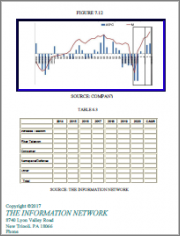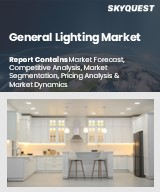
|
시장보고서
상품코드
1577460
세계의 LED 패널 라이트 시장 : 제품 유형, 최종 사용자, 기술, 와트 수별 예측(2025-2030년)LED Panel Light Market by Product Type (Recessed Mounted, Surface Mounted, Suspended Mounted), End-User (Commercial, Industrial, Residential), Technology, Wattage - Global Forecast 2025-2030 |
||||||
LED 패널 라이트 시장은 2023년에 223억 1,000만 달러로 평가되었고, 2024년에는 246억 1,000만 달러에 이를 것으로 예측되며, 복합 연간 성장률(CAGR) 11.13%로 성장하여, 2030년에는 467억 1,000만 달러에 달할 것으로 예상됩니다.
LED 패널 라이트 시장은 상업 공간, 주택 환경, 소매점, 산업 환경 등 다양한 용도를 포괄하고 있기 때문에 혁신과 성장의 여지가 큽니다. 에너지 효율, 긴 수명 및 낮은 발열을 특징으로 하는 LED 패널 조명은 지속 가능한 조명 솔루션으로 작동합니다. LED 패널의 필요성은 전력 소비와 유지 보수 비용을 줄이는 능력으로 인해 환경 친화적 인 건축물에 대한 노력에 필수적입니다. 주요 성장 요인으로는 에너지 효율적인 제품에 대한 의식이 높아지고, 엄격한 에너지 규제에 대응하고, 빛의 질과 설계 유연성을 향상시키는 기술의 진보 등이 있습니다. IoT 기술과의 통합은 원격 조작 및 광범위한 홈 오토메이션 시스템의 일부인 스마트 조명 솔루션을 가능하게 함으로써 비즈니스 기회를 창출합니다. 시장의 한계는 초기 설치 비용의 높이와 인프라가 부족한 지역에서의 기술 도입 장벽을 포함합니다. 또한 LED의 생산 공정에 관한 환경 문제도 과제가 되고 있습니다. 혁신 분야는 풍부하고, 발광 효율의 향상과 다양한 미적 및 기능적 요구 사항에 대응하는 사용자 정의 가능한 조명 솔루션의 설계 등 잠재적인 조사 수단이 있습니다. 업계는 보다 밝고 효율적인 패널로 이어지는 나노기술의 진보로부터 큰 혜택을 누릴 수 있습니다. 시장 기회를 포착하는 모범 사례로는 스마트 시티 프로젝트와의 전략적 파트너십과 도시화가 진행되는 신흥 시장에서의 제품 제공 확대 등이 있습니다.제조업체는 가격 감응도 문제를 해결하기 위해 자동화 및 지속 가능한 관행으로 인한 생산 비용 절감에 주력해야합니다. 시장은 경쟁이 심하고 급속한 기술 혁신과 다양한 세계 표준이 특징입니다. 기업은 스마트하고 연결된 주택을 목표로 하는 소비자의 동향을 예측하고 연구 개발에 투자하여 진화하는 수요에 대응하는 최첨단 솔루션을 개발해야 합니다. 비용 과제와 지속가능성에 대한 배려를 관리하면서 이러한 성장 기회에 주력함으로써 기업은 역동적인 시장 역학 중에서 확고한 존재감을 나타낼 수 있습니다.
| 주요 시장 통계 | |
|---|---|
| 기준년(2023) | 223억 1,000만 달러 |
| 예측년(2024) | 246억 1,000만 달러 |
| 예측년(2030) | 467억 1,000만 달러 |
| 복합 연간 성장률(CAGR)(%) | 11.13% |
시장 역학: 빠르게 진화하는 LED 패널 라이트 시장의 주요 시장 인사이트 공개
LED 패널 라이트 시장은 수요 및 공급의 역동적 인 상호 작용에 의해 변모하고 있습니다. 이러한 시장 역학의 진화를 이해함으로써 기업은 충분한 정보를 바탕으로 투자결정, 전략적 의사결정, 새로운 비즈니스 기회를 획득할 수 있습니다. 이러한 동향을 종합적으로 파악함으로써 기업은 정치적, 지리적, 기술적, 사회적, 경제적인 영역에 걸친 다양한 리스크를 경감할 수 있음과 동시에, 소비자 행동과 그것이 제조 비용이나 구매 동향에 미치는 영향을 보다 명확하게 이해할 수 있습니다.
- 시장 성장 촉진요인
- LED 조명 솔루션 수요를 밀어 올리는 지속 가능한 건축 관행의 동향의 고조
- 신흥국 시장에서 인프라 정비에 대한 투자가 확대되어 조명 제품의 매출을 견인
- LED 패널 라이트의 미적 매력의 향상과 디자인의 유연성이 다양한 건축 용도를 매료
- 낮은 유지 보수로 오래 지속되는 조명 옵션에 대한 소비자의 의식과 선호도 증가
- 시장 성장 억제요인
- LED 패널 조명의 장점과 장기적인 비용 절감에 관한 소비자의 인식과 이해가 한정적임
- LED 패널 조명의 시기 적절한 시장 투입에 영향을 주는 공급망 관리와 조달 지연의 과제
- 시장 기회
- 헬스케어와 접객산업에 있어서의 LED 패널 라이트의 용도 확대
- 모던한 인테리어 디자인에 의한 주택 공간에서의 LED 패널 라이트 채용 증가
- 보다 좋은 조명을 위해 교육기관에서 LED 패널 라이트의 기호의 높이
- 시장의 과제
- LED 패널 라이트 제조, 유통에 있어서의 국제 규격 및 규제에의 대응
- LED 패널 조명의 생산에 있어서공급 체인의 혼란과 원재료 부족에의 대응
Porter's Five Forces: LED 패널 라이트 시장을 탐색하는 전략 도구
Porter's Five Forces 프레임 워크는 시장 상황경쟁 구도를 이해하는 중요한 도구입니다. Porter's Five Forces Framework는 기업의 경쟁력을 평가하고 전략적 기회를 탐구하는 명확한 기술을 제공합니다. 이 프레임워크는 기업이 시장 내 세력도를 평가하고 신규 사업의 수익성을 판단하는 데 도움이 됩니다. 이러한 통찰을 통해 기업은 자사의 강점을 활용하고, 약점을 해결하고, 잠재적인 과제를 피할 수 있으며, 보다 강인한 시장에서의 포지셔닝을 보장할 수 있습니다.
PESTLE 분석 : LED 패널 라이트 시장에서 외부로부터의 영향 파악
외부 거시적 환경 요인은 LED 패널 라이트 시장의 성과 역학을 형성하는데 매우 중요한 역할을 합니다. 정치적, 경제적, 사회적, 기술적, 법적, 환경적 요인 분석은 이러한 영향을 탐색하는 데 필요한 정보를 제공합니다. PESTLE 요인을 조사함으로써 기업은 잠재적인 위험과 기회를 더 잘 이해할 수 있습니다. 이 분석을 통해 기업은 규제, 소비자 선호, 경제 동향의 변화를 예측하고 앞으로 예상되는 적극적인 의사 결정을 할 준비를 할 수 있습니다.
시장 점유율 분석 LED 패널 라이트 시장 경쟁 구도 파악
LED 패널 라이트 시장의 상세한 시장 점유율 분석을 통해 공급업체의 성과를 종합적으로 평가할 수 있습니다. 기업은 수익, 고객 기반, 성장률 등 주요 지표를 비교하여 경쟁 포지셔닝을 밝힐 수 있습니다. 이 분석을 통해 시장 집중, 단편화, 통합 동향을 밝혀내고 벤더들은 경쟁이 치열해지는 가운데 자사의 지위를 높이는 전략적 의사 결정을 내리는 데 필요한 지식을 얻을 수 있습니다.
FPNV 포지셔닝 매트릭스 LED 패널 라이트 시장에서 공급업체의 성능 평가
FPNV 포지셔닝 매트릭스는 LED 패널 라이트 시장에서 공급업체를 평가하는 중요한 도구입니다. 이 행렬을 통해 비즈니스 조직은 공급업체의 비즈니스 전략과 제품 만족도를 기준으로 평가하여 목표에 맞는 충분한 정보를 바탕으로 의사 결정을 내릴 수 있습니다. 네 가지 사분면을 통해 공급업체를 명확하고 정확하게 세분화하여 전략 목표에 가장 적합한 파트너 및 솔루션을 파악할 수 있습니다.
전략 분석 및 권장 LED 패널 라이트 시장에서 성공에 대한 길을 그립니다.
LED 패널 라이트 시장의 전략 분석은 시장에서의 프레즌스 강화를 목표로 하는 기업에 필수적입니다. 주요 자원, 역량 및 성과 지표를 검토함으로써 기업은 성장 기회를 파악하고 개선을 위해 노력할 수 있습니다. 이러한 접근 방식을 통해 경쟁 구도에서 과제를 극복하고 새로운 비즈니스 기회를 활용하여 장기적인 성공을 거둘 수 있는 체제를 구축할 수 있습니다.
이 보고서는 주요 관심 분야를 포괄하는 시장의 종합적인 분석을 제공합니다.
1. 시장 침투: 현재 시장 환경의 상세한 검토, 주요 기업의 광범위한 데이터, 시장 도달범위 및 전반적인 영향력 평가.
2. 시장 개척도: 신흥 시장의 성장 기회를 파악하고 기존 분야의 확장 가능성을 평가하며 미래 성장을 위한 전략적 로드맵을 제공합니다.
3. 시장 다양화: 최근 제품 출시, 미개척 지역, 업계의 주요 진보, 시장을 형성하는 전략적 투자를 분석합니다.
4. 경쟁 평가 및 정보 : 경쟁 구도를 철저히 분석하여 시장 점유율, 사업 전략, 제품 포트폴리오, 인증, 규제 당국 승인, 특허 동향, 주요 기업의 기술 진보 등을 검증합니다.
5. 제품 개발 및 혁신 : 미래 시장 성장을 가속할 것으로 예상되는 최첨단 기술, R&D 활동, 제품 혁신을 강조합니다.
또한 이해관계자가 충분한 정보를 얻고 의사결정을 할 수 있도록 중요한 질문에 대답하고 있습니다.
1. 현재 시장 규모와 향후 성장 예측은?
2. 최고의 투자 기회를 제공하는 제품, 부문 및 지역은 어디입니까?
3. 시장을 형성하는 주요 기술 동향과 규제의 영향은?
4. 주요 벤더의 시장 점유율과 경쟁 포지션은?
5. 벤더 시장 진입, 철수 전략의 원동력이 되는 수익원과 전략적 기회는 무엇인가?
목차
제1장 서문
제2장 조사 방법
제3장 주요 요약
제4장 시장 개요
제5장 시장 인사이트
- 시장 역학
- 성장 촉진요인
- 지속 가능한 건축 관행 증가로 LED 조명 솔루션에 대한 수요가 증가하고 있습니다.
- 신흥 시장의 인프라 개발 투자 증가가 조명제품 매출 견인
- LED 패널 라이트의 미관과 디자인의 유연성이 향상되어 다양한 건축 용도에 받아들여지고 있습니다.
- 메인터넌스의 수고가 적고 오래 지속되는 조명 옵션에 대한 소비자의 의식과 취향이 높아지고 있다
- 억제요인
- LED 패널 라이트의 장점과 장기적인 비용 절감에 관한 소비자의 인식과 이해가 한정되어 있다
- 공급망 관리의 과제와 조달의 지연이, 시장에서의 LED 패널 라이트의 시기 적절한 공급에 영향을 미치고 있다
- 기회
- 헬스케어 및 접객 업계에서 LED 패널 라이트의 용도 확대
- 모던한 인테리어 디자인에 의해 주택 공간에서의 LED 패널 라이트의 채용이 증가
- 교육기관에서는 보다 좋은 조명을 요구해 LED 패널 라이트가 선호되는 경향이 높아지고 있다
- 과제
- LED 패널 라이트의 제조 및 유통에 관한 국제 기준과 규제에 준거의 확보
- LED 패널 라이트의 생산에 있어서공급 체인의 혼란과 원재료 부족에의 대응
- 성장 촉진요인
- 시장 세분화 분석
- Porter's Five Forces 분석
- PESTEL 분석
- 정치적
- 경제
- 사교
- 기술적
- 법률상
- 환경
제6장 LED 패널 라이트 시장 : 제품 유형별
- 임베디드식
- 표면 실장
- 매달아 마운트
제7장 LED 패널 라이트 시장 : 최종 사용자별
- 상업용
- 산업
- 주택용
제8장 LED 패널 라이트 시장 : 기술별
- 지도된
- OLED
제9장 LED 패널 라이트 시장 와트 에이지
- 100W-150W
- 50W-100W
- 150W 이상
- 50W 이하
제10장 아메리카의 LED 패널 라이트 시장
- 아르헨티나
- 브라질
- 캐나다
- 멕시코
- 미국
제11장 아시아태평양의 LED 패널 라이트 시장
- 호주
- 중국
- 인도
- 인도네시아
- 일본
- 말레이시아
- 필리핀
- 싱가포르
- 한국
- 대만
- 태국
- 베트남
제12장 유럽, 중동 및 아프리카의 LED 패널 라이트 시장
- 덴마크
- 이집트
- 핀란드
- 프랑스
- 독일
- 이스라엘
- 이탈리아
- 네덜란드
- 나이지리아
- 노르웨이
- 폴란드
- 카타르
- 러시아
- 사우디아라비아
- 남아프리카
- 스페인
- 스웨덴
- 스위스
- 터키
- 아랍에미리트(UAE)
- 영국
제13장 경쟁 구도
- 시장 점유율 분석(2023년)
- FPNV 포지셔닝 매트릭스(2023년)
- 경쟁 시나리오 분석
- 전략 분석과 제안
The LED Panel Light Market was valued at USD 22.31 billion in 2023, expected to reach USD 24.61 billion in 2024, and is projected to grow at a CAGR of 11.13%, to USD 46.71 billion by 2030.
The LED panel light market offers significant scope for innovation and growth as it encompasses a range of applications including commercial spaces, residential settings, retail outlets, and industrial environments. Defined by energy efficiency, longevity, and low heat emissions, LED panel lights serve as sustainable lighting solutions. The necessity of LED panels stems from their ability to reduce electricity consumption and maintenance costs, which makes them crucial for eco-friendly building initiatives. Key growth factors include the increasing awareness of energy-efficient products, compliance with stringent energy regulations, and technological advancements that improve light quality and design flexibility. Opportunities arise from integration with IoT technologies, enabling smart lighting solutions that can be controlled remotely or be part of a broader home automation system. Market limitations include high initial installation costs and technological adoption barriers in regions with inadequate infrastructure. Environmental concerns over LED production processes also pose challenges. Innovation areas are abundant, with potential research avenues in enhancing luminous efficacy and designing customizable lighting solutions to cater to diverse aesthetic and functional requirements. The industry can benefit greatly from advances in nanotechnology, leading to brighter, more efficient panels. Best practices for capturing market opportunities involve strategic partnerships with smart city projects and expanding offerings in emerging markets where urbanization is on the rise. Manufacturers should focus on reducing production costs through automation and sustainable practices to address price sensitivity issues. The market is competitive, characterized by rapid technological changes and varying global standards. Companies should anticipate consumer trends toward smart, connected homes and invest in R&D to develop cutting-edge solutions that meet evolving demands. By focusing on these growth opportunities while managing cost challenges and sustainability considerations, businesses can ensure a strong market presence in the dynamic LED panel light industry.
| KEY MARKET STATISTICS | |
|---|---|
| Base Year [2023] | USD 22.31 billion |
| Estimated Year [2024] | USD 24.61 billion |
| Forecast Year [2030] | USD 46.71 billion |
| CAGR (%) | 11.13% |
Market Dynamics: Unveiling Key Market Insights in the Rapidly Evolving LED Panel Light Market
The LED Panel Light Market is undergoing transformative changes driven by a dynamic interplay of supply and demand factors. Understanding these evolving market dynamics prepares business organizations to make informed investment decisions, refine strategic decisions, and seize new opportunities. By gaining a comprehensive view of these trends, business organizations can mitigate various risks across political, geographic, technical, social, and economic domains while also gaining a clearer understanding of consumer behavior and its impact on manufacturing costs and purchasing trends.
- Market Drivers
- Rising trend of sustainable building practices boosting the demand for LED lighting solutions
- Growing investments in infrastructure development across emerging markets driving lighting product sales
- Enhanced aesthetic appeal and design flexibility of LED panel lights attracting various architectural applications
- Increasing consumer awareness and preference for low-maintenance and long-lasting lighting options
- Market Restraints
- Limited consumer awareness and understanding regarding the benefits and long-term cost savings of LED panel lights
- Challenges in supply chain management and procurement delays affecting the timely availability of LED panel lights in the market
- Market Opportunities
- Expanding applications of LED panel lights in the healthcare and hospitality industries
- Increasing adoption of LED panel lights in residential spaces due to modern interior designs
- Growing preference for LED panel lights in educational institutions for better illumination
- Market Challenges
- Ensuring compliance with international standards and regulations for LED panel light manufacturing and distribution
- Addressing supply chain disruptions and raw material shortages in the production of LED panel lights
Porter's Five Forces: A Strategic Tool for Navigating the LED Panel Light Market
Porter's five forces framework is a critical tool for understanding the competitive landscape of the LED Panel Light Market. It offers business organizations with a clear methodology for evaluating their competitive positioning and exploring strategic opportunities. This framework helps businesses assess the power dynamics within the market and determine the profitability of new ventures. With these insights, business organizations can leverage their strengths, address weaknesses, and avoid potential challenges, ensuring a more resilient market positioning.
PESTLE Analysis: Navigating External Influences in the LED Panel Light Market
External macro-environmental factors play a pivotal role in shaping the performance dynamics of the LED Panel Light Market. Political, Economic, Social, Technological, Legal, and Environmental factors analysis provides the necessary information to navigate these influences. By examining PESTLE factors, businesses can better understand potential risks and opportunities. This analysis enables business organizations to anticipate changes in regulations, consumer preferences, and economic trends, ensuring they are prepared to make proactive, forward-thinking decisions.
Market Share Analysis: Understanding the Competitive Landscape in the LED Panel Light Market
A detailed market share analysis in the LED Panel Light Market provides a comprehensive assessment of vendors' performance. Companies can identify their competitive positioning by comparing key metrics, including revenue, customer base, and growth rates. This analysis highlights market concentration, fragmentation, and trends in consolidation, offering vendors the insights required to make strategic decisions that enhance their position in an increasingly competitive landscape.
FPNV Positioning Matrix: Evaluating Vendors' Performance in the LED Panel Light Market
The Forefront, Pathfinder, Niche, Vital (FPNV) Positioning Matrix is a critical tool for evaluating vendors within the LED Panel Light Market. This matrix enables business organizations to make well-informed decisions that align with their goals by assessing vendors based on their business strategy and product satisfaction. The four quadrants provide a clear and precise segmentation of vendors, helping users identify the right partners and solutions that best fit their strategic objectives.
Strategy Analysis & Recommendation: Charting a Path to Success in the LED Panel Light Market
A strategic analysis of the LED Panel Light Market is essential for businesses looking to strengthen their global market presence. By reviewing key resources, capabilities, and performance indicators, business organizations can identify growth opportunities and work toward improvement. This approach helps businesses navigate challenges in the competitive landscape and ensures they are well-positioned to capitalize on newer opportunities and drive long-term success.
Key Company Profiles
The report delves into recent significant developments in the LED Panel Light Market, highlighting leading vendors and their innovative profiles. These include Bajaj Electricals, Cree Lighting, Everlight Electronics, Foshan Electrical and Lighting, GlacialTech, HPL Electric and Power, Illuxtron International, Ledvance, LumiGrow, MaxLite, Moser Baer, Opple Lighting, Osram Opto Semiconductors, Photon Systems Instruments, Rishang LED, Seoul Semiconductor, Syska LED Lights, Wipro Lighting, and Yankon Lighting.
Market Segmentation & Coverage
This research report categorizes the LED Panel Light Market to forecast the revenues and analyze trends in each of the following sub-markets:
- Based on Product Type, market is studied across Recessed Mounted, Surface Mounted, and Suspended Mounted.
- Based on End-User, market is studied across Commercial, Industrial, and Residential.
- Based on Technology, market is studied across LED and OLED.
- Based on Wattage, market is studied across 100W-150W, 50W-100W, Above 150W, and Below 50W.
- Based on Region, market is studied across Americas, Asia-Pacific, and Europe, Middle East & Africa. The Americas is further studied across Argentina, Brazil, Canada, Mexico, and United States. The United States is further studied across California, Florida, Illinois, New York, Ohio, Pennsylvania, and Texas. The Asia-Pacific is further studied across Australia, China, India, Indonesia, Japan, Malaysia, Philippines, Singapore, South Korea, Taiwan, Thailand, and Vietnam. The Europe, Middle East & Africa is further studied across Denmark, Egypt, Finland, France, Germany, Israel, Italy, Netherlands, Nigeria, Norway, Poland, Qatar, Russia, Saudi Arabia, South Africa, Spain, Sweden, Switzerland, Turkey, United Arab Emirates, and United Kingdom.
The report offers a comprehensive analysis of the market, covering key focus areas:
1. Market Penetration: A detailed review of the current market environment, including extensive data from top industry players, evaluating their market reach and overall influence.
2. Market Development: Identifies growth opportunities in emerging markets and assesses expansion potential in established sectors, providing a strategic roadmap for future growth.
3. Market Diversification: Analyzes recent product launches, untapped geographic regions, major industry advancements, and strategic investments reshaping the market.
4. Competitive Assessment & Intelligence: Provides a thorough analysis of the competitive landscape, examining market share, business strategies, product portfolios, certifications, regulatory approvals, patent trends, and technological advancements of key players.
5. Product Development & Innovation: Highlights cutting-edge technologies, R&D activities, and product innovations expected to drive future market growth.
The report also answers critical questions to aid stakeholders in making informed decisions:
1. What is the current market size, and what is the forecasted growth?
2. Which products, segments, and regions offer the best investment opportunities?
3. What are the key technology trends and regulatory influences shaping the market?
4. How do leading vendors rank in terms of market share and competitive positioning?
5. What revenue sources and strategic opportunities drive vendors' market entry or exit strategies?
Table of Contents
1. Preface
- 1.1. Objectives of the Study
- 1.2. Market Segmentation & Coverage
- 1.3. Years Considered for the Study
- 1.4. Currency & Pricing
- 1.5. Language
- 1.6. Stakeholders
2. Research Methodology
- 2.1. Define: Research Objective
- 2.2. Determine: Research Design
- 2.3. Prepare: Research Instrument
- 2.4. Collect: Data Source
- 2.5. Analyze: Data Interpretation
- 2.6. Formulate: Data Verification
- 2.7. Publish: Research Report
- 2.8. Repeat: Report Update
3. Executive Summary
4. Market Overview
5. Market Insights
- 5.1. Market Dynamics
- 5.1.1. Drivers
- 5.1.1.1. Rising trend of sustainable building practices boosting the demand for LED lighting solutions
- 5.1.1.2. Growing investments in infrastructure development across emerging markets driving lighting product sales
- 5.1.1.3. Enhanced aesthetic appeal and design flexibility of LED panel lights attracting various architectural applications
- 5.1.1.4. Increasing consumer awareness and preference for low-maintenance and long-lasting lighting options
- 5.1.2. Restraints
- 5.1.2.1. Limited consumer awareness and understanding regarding the benefits and long-term cost savings of LED panel lights
- 5.1.2.2. Challenges in supply chain management and procurement delays affecting the timely availability of LED panel lights in the market
- 5.1.3. Opportunities
- 5.1.3.1. Expanding applications of LED panel lights in the healthcare and hospitality industries
- 5.1.3.2. Increasing adoption of LED panel lights in residential spaces due to modern interior designs
- 5.1.3.3. Growing preference for LED panel lights in educational institutions for better illumination
- 5.1.4. Challenges
- 5.1.4.1. Ensuring compliance with international standards and regulations for LED panel light manufacturing and distribution
- 5.1.4.2. Addressing supply chain disruptions and raw material shortages in the production of LED panel lights
- 5.1.1. Drivers
- 5.2. Market Segmentation Analysis
- 5.3. Porter's Five Forces Analysis
- 5.3.1. Threat of New Entrants
- 5.3.2. Threat of Substitutes
- 5.3.3. Bargaining Power of Customers
- 5.3.4. Bargaining Power of Suppliers
- 5.3.5. Industry Rivalry
- 5.4. PESTLE Analysis
- 5.4.1. Political
- 5.4.2. Economic
- 5.4.3. Social
- 5.4.4. Technological
- 5.4.5. Legal
- 5.4.6. Environmental
6. LED Panel Light Market, by Product Type
- 6.1. Introduction
- 6.2. Recessed Mounted
- 6.3. Surface Mounted
- 6.4. Suspended Mounted
7. LED Panel Light Market, by End-User
- 7.1. Introduction
- 7.2. Commercial
- 7.3. Industrial
- 7.4. Residential
8. LED Panel Light Market, by Technology
- 8.1. Introduction
- 8.2. LED
- 8.3. OLED
9. LED Panel Light Market, by Wattage
- 9.1. Introduction
- 9.2. 100W-150W
- 9.3. 50W-100W
- 9.4. Above 150W
- 9.5. Below 50W
10. Americas LED Panel Light Market
- 10.1. Introduction
- 10.2. Argentina
- 10.3. Brazil
- 10.4. Canada
- 10.5. Mexico
- 10.6. United States
11. Asia-Pacific LED Panel Light Market
- 11.1. Introduction
- 11.2. Australia
- 11.3. China
- 11.4. India
- 11.5. Indonesia
- 11.6. Japan
- 11.7. Malaysia
- 11.8. Philippines
- 11.9. Singapore
- 11.10. South Korea
- 11.11. Taiwan
- 11.12. Thailand
- 11.13. Vietnam
12. Europe, Middle East & Africa LED Panel Light Market
- 12.1. Introduction
- 12.2. Denmark
- 12.3. Egypt
- 12.4. Finland
- 12.5. France
- 12.6. Germany
- 12.7. Israel
- 12.8. Italy
- 12.9. Netherlands
- 12.10. Nigeria
- 12.11. Norway
- 12.12. Poland
- 12.13. Qatar
- 12.14. Russia
- 12.15. Saudi Arabia
- 12.16. South Africa
- 12.17. Spain
- 12.18. Sweden
- 12.19. Switzerland
- 12.20. Turkey
- 12.21. United Arab Emirates
- 12.22. United Kingdom
13. Competitive Landscape
- 13.1. Market Share Analysis, 2023
- 13.2. FPNV Positioning Matrix, 2023
- 13.3. Competitive Scenario Analysis
- 13.4. Strategy Analysis & Recommendation
Companies Mentioned
- 1. Bajaj Electricals
- 2. Cree Lighting
- 3. Everlight Electronics
- 4. Foshan Electrical and Lighting
- 5. GlacialTech
- 6. HPL Electric and Power
- 7. Illuxtron International
- 8. Ledvance
- 9. LumiGrow
- 10. MaxLite
- 11. Moser Baer
- 12. Opple Lighting
- 13. Osram Opto Semiconductors
- 14. Photon Systems Instruments
- 15. Rishang LED
- 16. Seoul Semiconductor
- 17. Syska LED Lights
- 18. Wipro Lighting
- 19. Yankon Lighting



















